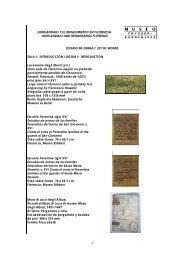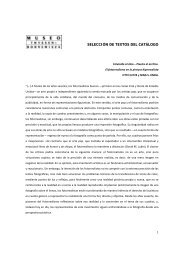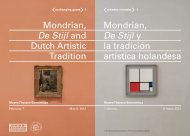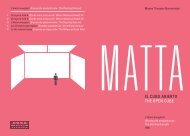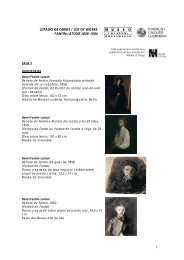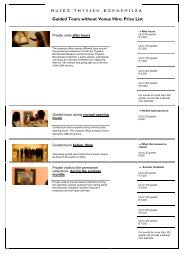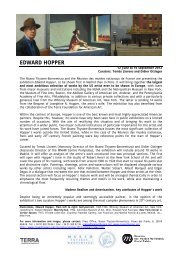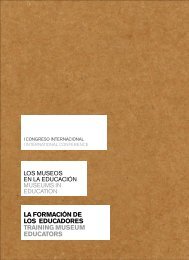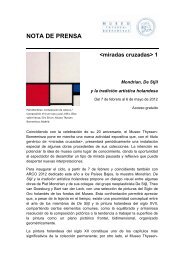CronologÃa / Chronology - Museo Thyssen-Bornemisza
CronologÃa / Chronology - Museo Thyssen-Bornemisza
CronologÃa / Chronology - Museo Thyssen-Bornemisza
You also want an ePaper? Increase the reach of your titles
YUMPU automatically turns print PDFs into web optimized ePapers that Google loves.
CAMILLE PISSARO (1830‐1903)Pissarro nace el 10 de julio de 1830 en la isla de Santo Tomás (Islas Vírgenes), propiedad de lacorona danesa. Es el tercero de los cuatro hijos de Frédéric Pissarro y la criolla RachelManzana‐Pomié, de origen judío francés y con dos hijas de su primer matrimonio con el tío deFrédéric, Isaac Petit. Pissarro tiene la nacionalidad danesa y habla francés, español e inglés.En 1842, con 12 años, sus padres le envían a estudiar a Passy, cerca de París, dondeAuguste Savary, pintor de paisajes y profesor de dibujo, descubre y fomenta su don para eldibujo. En 1847 vuelve a Santo Tomás para trabajar en los negocios familiares del puerto yconoce al pintor danés Fritz Melbye, con el que viaja a Santo Domingo, Haití y Venezuela.En 1855 se marcha definitivamente a París para continuar su formación como pintor. Allírecibe clases particulares de profesores de la Escuela de Bellas Artes y comparte el estudiocon Anton Melbye, el hermano de Fritz. Pero, descontento con la enseñanza académica, seinscribe en 1857 en la Académie Suisse, donde años después coincidirá con Paul Cézanne.Entonces conoce a Camille Corot, que imparte clases informales a pequeños grupos dealumnos a los que recomienda salir a pintar al aire libre.El primer reconocimiento oficial llega en 1859, cuando el jurado del Salón acepta uno desus cuadros y aparece en el folleto como discípulo de Anton Melbye. Durante los primerosaños, Pissarro ha firmado sus obras como Pizarro; ahora adopta ya la grafía francesa.El año siguiente, Pissarro conoce a su gran amigo el pintor Ludovic Piette, a ArmandGuillaumin y a Claude Monet, quien le presentará años después a Frédéric Bazille, AlfredSisley y Auguste Renoir. Por aquel entonces, la familia Pissarro se ha trasladado a Francia ycontrata a una joven católica como ayudante de cocina, Julie Vellay, que se convertirá en lacompañera de Pissarro durante el resto de su vida, a pesar de la oposición de los padres delartista. En 1863 nace Lucien, el primer hijo de Camille y Julie, y los tres se trasladan a lasafueras de París. Ese mismo año, el pintor expone en el Salón de los Rechazados tres obrasque habían sido desestimadas por el jurado del Salón oficial. El Salón de 1864 sí acepta dosde sus obras y figura en el catálogo como alumno de Corot y de Melbye.En 1865 muere su padre y nace su segunda hija, Jeanne‐Rachel. Expone dos obras en elSalón pero vende muy poco y su situación financiera será crítica durante años. Se mudan aPontoise, una localidad de fácil conexión con París por tren que anteriormente habíaatraído a artistas como Charles‐François Daubigny, Berthe Morisot y Honoré Daumier.El Salón de 1866 incluye una obra de Pissarro que recibe una buena crítica de Émile Zola.En esa época conoce a Édouard Manet y participa en las tertulias de artistas del parisiensecafé Guerbois y del estudio de Bazille con Monet, Renoir, Sisley y otros pintores. En 1867,Pissarro, Monet, Renoir, Sisley, Bazille, Manet y Cézanne son excluidos del Salón oficial ydel Salón de los Rechazados. Courbet les insta a exponer juntos fuera del circuito y planeanuna exposición que finalmente no se lleva a cabo. Un año después, Pissarro vuelve al Salóncon dos obras gracias a Daubigny, miembro del jurado, y Zola vuelve a escribir unhalagador artículo sobre él.
En 1869, la familia Pissarro se muda a Louveciennes, una localidad al oeste de París muyfrecuentada por los impresionistas y, durante el invierno de 1870, Pissarro y Monet pintanallí las grandes nevadas caídas. Este año, además, le aceptan dos lienzos en el Salón.En septiembre estalla la guerra franco‐prusiana y Pissarro y su familia se refugian en lagranja de su amigo Piette, en la localidad bretona de Montfoucault, para después mudarsea Londres, como hacen otros artistas franceses. Allí, en 1871, Daubigny le presenta almarchante Paul Durand‐Ruel, que le pone en contacto con Monet, con quien participa en laFirst Annual International Exhibition of Fine Art de South Kensington.En junio Camille y Julie se casan en Croydon, Surrey, y poco después vuelven a Francia,donde encuentran que su casa de Louveciennes ha sido saqueada: se salvan sólo unas 40obras de las 1.500 que allí se guardaban, la producción de Pissarro de los últimos veinteaños. En noviembre Julie tiene a su cuarto hijo, Georges‐Henri (la tercera, Adèle‐Emma,murió en 1870, tres semanas después de nacer). Durante el año siguiente, Durand‐Ruelempieza a comprarle obras de forma periódica y por primera vez gana dinero suficientepara mantener a su familia. Pissarro pinta en Louveciennes con Sisley y frecuenta a Renoir,y en 1873 trabajará con Cézanne en Pontoise y en Auvers. Un amigo de Pissarro, el doctorGachet, que también es grabador, le insta a él, a Guillaumin y a Cézanne a trabajar estatécnica. Cada uno firma su obra con un símbolo y Pissarro escoge una col.Más adelante, planea con Monet la creación de una sociedad cooperativa de pintoresbasada en las de trabajadores para exponer y vender obras sin pasar por el jurado del Salóny, dos semanas antes de que comience el Salón de 1874, abre sus puertas la primeraexposición de la Société Anonyme Coopérative des Artistes, Peintres, Sculpteurs, Graveurs,etc, en la que participan 30 pintores y 167 obras ‐5 de Pissarro‐, aunque esta primeraexposición impresionista es un fracaso. Mientras tanto, Julie da a luz a su quinto hijo, Félix‐Camille, y Pissarro vuelve a sentir la presión económica porque apenas vende cuadros.En 1876 tiene lugar la Segunda Exposición Impresionista en la Galerie Durand‐Ruel sin quemejoren las ventas ni la opinión de crítica y público. Por tercer año consecutivo, los Pissarropasan el otoño en Montfoucault, donde el artista encuentra numerosos motivos pictóricosy trabaja intensamente. Pinta además cerámica, que es más fácil de vender.La Tercera Exposición Impresionista se celebra en 1877 con 241 obras, 22 de Pissarro. Elaño siguiente, el artista pasa largas temporadas en París intentando vender sus obras yJulie, molesta por su ausencia, se traslada también con sus hijos. Allí nace su sexto niño,Ludovic‐Rodolphe, llamado así en recuerdo de su amigo Ludovic Piette, fallecido mesesantes y que tanto le había ayudado.En 1879 tiene lugar la Cuarta Exposición Impresionista, en la que Pissarro muestra 38 obrasy participan 15 pintores, entre los que se encuentra Gauguin pero no Cézanne, Renoir,Sisley ni Morisot. Un año después, Cézanne, Renoir, Sisley y Monet tampoco participan enla Quinta Exposición Impresionista y prefieren acudir al Salón. En la Sexta, que tiene lugaren 1881, Pissarro aporta 28 obras y en la Séptima, 26, edición en la que sí participanMonet, Sisley y Renoir gracias al empeño del artista y de Caillebotte por conciliar al grupo.
En 1881 nace la séptima hija de los Pissarro, Jeanne‐Marguerite. Julie quiere que el mayor,Lucien, les ayude económicamente pero Pissarro prefiere que desarrolle su talento artísticoy en 1883 le envía a Inglaterra. En esa época, Durand‐Ruel es su único marchante, conderechos exclusivos sobre su obra, y le organiza una primera exposición individual con 70piezas. Después, Pissarro se traslada a Ruán para buscar nuevos temas y pinta 13 obras.En 1884 alquila una casa en Éragny, cerca de Pontoise y a dos horas de París, un lugar quepara el artista será una importante fuente de inspiración. Mientras tanto, vende sus lienzosa precios muy bajos para poder subsistir y realiza acuarelas para pequeños marchantes.Julie da a luz a su octavo y último hijo, Paul‐Émile.Un año después, y tras conocer a Paul Signac y Georges Seurat, Pissarro experimenta con elpuntillismo. En esa época, el artista, que lee habitualmente el periódico socialista LeProlétaire, Le Revolté de Jean Grave y la obra de Proudhon, Flaubert, Kropotkin y Zola ‐quien le envía personalmente su novela Germinal‐, adopta las ideas anarquistas.A partir de 1866, Pissarro, que sigue pintando al estilo puntillista a pesar de que casi todoslos críticos lo rechazan y pocos coleccionistas lo aprecian, decide trabajar con otrosmarchantes. Ese mismo año tiene lugar la Octava Exposición Impresionista, en la queSignac, Seurat, Pissarro y su hijo Lucien muestran sus obras y Monet, Renoir, Sisley yCaillebotte deciden no participar. Pissarro conoce a Vincent van Gogh y un año despuésTheo van Gogh, hermano y marchante del pintor, comienza a vender su obra.En 1888 viaja a Éragny y recibe la visita de Maximilien Luce, con quien comparte las ideasanarquistas y el gusto por el neoimpresionismo, aunque este estilo artístico le empieza aprovocar dudas, consciente de que es un trabajo lento y no se vende bien –lo abandonarádefinitivamente en 1890‐. Durante el mes siguiente, el problema ocular que padece desde1880 se recrudece y contrae una infección que le impide trabajar. En 1889 muere su madrey su hermano Alfred el año siguiente.Theo le pide a Pissarro que se haga cargo de Vincent, que acaba de salir del asilo en el queestaba internado por problemas psiquiátricos, pero Julie se opone y Pissarro le recomiendaque consulte al doctor Gachet para ayudarle durante la convalecencia. Poco después, elmarchante organiza una muestra de su obra en la que sólo se venden cinco lienzos. Acomienzos del verano, Pissarro, Luce y Lucien viajan a Londres a visitar a su hijo Georges.Pinta vistas de Hyde Park, de los jardines de Kensington y del Puente de Charing Cross.Georges regresa a casa mientras Lucien se instala en Londres, donde da clases de dibujo.En 1891 muere Theo van Gogh y Pissarro pone sus obras a disposición del marchanteAlphonse Portier. Se agrava su enfermedad ocular y le operan en julio, por lo que tiene quepintar desde la ventana. Vuelve a Éragny y recibe a jóvenes estudiantes enviados por lapintora Mary Cassatt, que le está ayudando a vender sus obras a coleccionistasamericanos. Además, varios marchantes empiezan a competir por sus trabajos y suretrospectiva en la galería Durand‐Ruel en 1892 es un éxito.En 1893 viaja continuamente a París hasta que cae enfermo y se ve obligado a permanecerallí y trabajar desde la ventana de su habitación. La Galerie Durand‐Ruel organiza su
segunda exposición individual con 41 obras recientes y, poco después, se somete a unanueva operación ocular. Un año después, el marchante organiza la tercera retrospectiva.A principios de 1896, Pissarro se instala en Ruán y pinta numerosas vistas de la ciudad. Enprimavera, Durand‐Ruel presenta 35 de sus obras, incluyendo once de estas vistas, congran éxito y numerosas ventas. En septiembre vuelve a Ruán y pinta trece óleos en diezsemanas. Un año después, su marchante le compra todas las vistas urbanas de París queposee y le anima a volver a realizar una nueva serie. Poco después, Durand‐Ruel presentala primera exposición de Pissarro en su galería de la Quinta Avenida de Nueva York, en laque se exponen 42 obras, y el artista viaja a Londres para ver a Lucien, que está enfermo,donde realiza siete vistas de Bedford Park. A su vuelta muere su hijo Félix de tuberculosis.A principios de 1898, Pissarro se instala en París en la Rue de Rivoli, con unas vistasmagníficas de la Ópera y de la esquina de la Place du Palais Royal. Mientras tanto, el AffaireDreyfus divide Francia. Zola publica una carta abierta al presidente de la Repúblicadenunciando la injusticia cometida contra el oficial judío Alfred Dreyfus y huye a Londres.Los intelectuales, incluido Pissarro, se muestran a favor de un nuevo juicio para Dreyfus,pero Degas, Renoir y Guillaumin rehúyen al artista por apoyar la causa.En julio vuelve a Ruán, donde pinta veinte obras y a principios de 1899 se instala en Paríscon su familia, donde alquila un apartamento en la Rue de Rivoli y pinta junto a la ventanacatorce vistas del Jardín de las Tullerías. En junio se traslada nuevamente a Éragny y enseptiembre se va a Varengeville‐sur‐Mer, al oeste de Dieppe, donde pinta siete paisajes.En 1900, París acoge de nuevo la Exposición Universal. En la Centennale –la exposicióninternacional de arte celebrada en el Grand Palais– se dedica una sala entera alimpresionismo, donde Pissarro muestra siete óleos y un dibujo. Agotadas ya las vistas delJardín de las Tullerías, alquila un piso en la Île de la Cité.En 1901 Pissarro consigue que sus dos principales marchantes, Durand‐Ruel y Bernheim‐Jeune, compitan entre sí por su trabajo y ve cómo aumentan los precios de sus obras. Pasael verano en Dieppe, donde realiza vistas de la iglesia de Saint‐Jacques y del mercado, y portercer año consecutivo pasa el mes de octubre en Éragny y el invierno en París.En febrero de 1902, se inaugura en la galería Bernheim‐Jeune una exposición de la serie deVétheuil de Claude Monet y de obras recientes de Pissarro, entre las que destacan cincovistas de Dieppe y ocho de París aclamadas por la crítica. Durante el verano reside enDieppe, donde pintará 21 vistas del puerto, en otoño vuelve a Éragny y en invierno a París.El año siguiente se traslada a Éragny, donde continúa sus series de primavera y viaja unosdías a Dieppe para trabajar en las estivales. Después pasa el verano en El Havre donde porprimera vez una institución pública, el Musée du Havre, adquiere obra del artista.Finalmente vuelve a París, donde realiza su cuarto y último Autorretrato. El 29 deseptiembre participa en una peregrinación en honor a Zola, fallecido el año anterior, y caeenfermo. El 13 de noviembre de 1903 muere acompañado por su familia y es enterrado enel cementerio del Père‐Lachaise. Un año después, la galería Durand‐Ruel organiza una granretrospectiva de Pissarro que muestra 130 obras.
CAMILLE PISSARRO (1830‐1903)Camille Pissarro was born on 10 July 1830 on the island of Saint Thomas (now US VirginIslands), an overseas territory of Denmark. He was the third of the four children of FrédéricPissarro and the Creole Rachel Manzana‐Pomié who was of French origin and had twodaughters from her previous marriage to Frédéric’s uncle, Isaac Petit. Pissarro had Danishnationality and spoke French, English and Spanish.In 1842 at the age of 12 his parents sent him to study in Passy near Paris, where the landscapepainter and drawing instructor Auguste Savary discovered and encouraged his talent fordrawing. In 1847 Pissarro returned to Saint Thomas to work in the family businesses in theport. While there he met the Danish painter Fritz Melbye with whom he travelled to SantoDomingo, Haiti and Venezuela.In 1855 Pissarro left permanently for Paris to continue his training as a painter. He attendedclasses at the École des Beaux‐Arts and shared a studio with Anton Melbye, the brother ofFritz. Dissatisfied with academic teaching, in 1857 Pissarro enrolled at the Académie Suissewhere some years later Paul Cézanne studied. At this point Pissarro met Camille Corot, whogave informal classes in small groups to pupils whom he encouraged to work outdoors.Pissarro’s first official recognition came in 1859 when the Salon jury accepted one of hispaintings. He is listed in the leaflet as a pupil of Anton Melbye. Initially he signed his work as“Pizarro”, but from this point on he adopted the French spelling.The following year Pissarro met the painter Ludovic Piette, who would become a close friend,as well as Armand Guillaumin and Claude Monet, who introduced him some years later toFrédéric Bazille, Alfred Sisley and Auguste Renoir. At that date the Pissarro family had movedto France and were employing a young Catholic girl, Julie Vellay, as a kitchen maid. Vellaybecame Pissarro’s partner for the rest of his life, despite his parents’ opposition. In 1863 theirfirst child, Lucien, was born and the three moved to the outskirts of Paris. That same yearPissarro exhibited three works at the Salon des Refusés that had been rejected by the officialSalon. At the 1864 Salon, however, he showed two works and is listed in the catalogue as apupil of Corot and Melbye.In 1865 Pissarro’s father died and his second child, Jeanne‐Rachel, was born. He exhibited twoworks at the Salon but sold very little and his financial situation was extremely perilous duringthis period. The couple moved to Pontoise, a town with good train connections to Paris thathad already attracted artists such as Charles‐François Daubigny, Berthe Morisot and HonoréDaumier.The 1866 Salon included a work by Pissarro that was critically acclaimed by Émile Zola. Duringthis period he met Édouard Manet and participated in the artists’ debates held at the CaféGuerbois in Paris and at Bazille’s studio. Among the participants were Monet, Renoir, Sisleyand other painters. In 1867 Pissarro, Monet, Renoir, Sisley, Bazille, Manet and Cézanne wereexcluded from the official Salon and the Salon des Refusés. Courbet encouraged them toexhibit outside official circles and they planned an exhibition which ultimately did not takeplace. One year later Pissarro was again present at the Salon with two works, thanks toDaubigny, who was on the jury. Zola wrote a highly positive article about him.In 1869 the Pissarro family moved to Louveciennes, a town to the west of Paris that wasregularly visited by the Impressionists. During the winter of 1870 Pissarro and Monet paintedthe heavy snowfalls there. That same year two of his canvases were accepted for the Salon.
The Franco‐Prussian war broke out in September 1870 and Pissarro and his family took refugein his friend Piette’s farm in the village of Montfoucault in Brittany. They then moved toLondon, as did other French artists at this time. There, in 1871, Daubigny introduced Pissarroto the art dealer Paul Durand‐Ruel, who put him in contact with Monet. They both participatedin the First Annual International Exhibition of Fine Art in South Kensington.In June, Camille and Julie were married in Croydon, Surrey, returning soon after to Francewhere they found that their house in Louveciennes had been ransacked. Only 40 worksremained of the 1,500 that had been stored there, representing Pissarro’s output of the pasttwenty years. In November of that year Julie had their fourth child, George Henri (the third,Adèle‐Emma, died in 1870 three weeks after she was born). During the following year Durand‐Ruel began to purchase works from Pissarro on a regular basis and for the first time he earnedenough money to support his family. He painted with Sisley in Louveciennes and socialisedwith Renoir. In 1873 he worked with Cézanne in Pontoise and in Auvers. His friend Dr Gachet,an amateur printmaker, encouraged Pissarro, Sisley, Guillaumin and Cézanne to experimentwith this technique. Each signed his work with a symbol and Pissarro chose a cabbage.At a later date Pissarro and Monet planned the creation of a cooperative society of paintersbased on workers’ cooperatives, with the aim of exhibiting and selling works without having tosubmit them to the Salon jury. Two weeks before the start of the 1874 Salon the firstexhibition of the “Société Anonyme Coopérative des Artistes, Peintres, Sculpteurs, Graveursetc.,” opened. It involved the participation of 30 painters and 167 works (5 by Pissarro). Thisfirst Impressionist exhibition was a complete failure. Julie gave birth to their fifth child, FélixCamille, and Pissarro once again experienced serious money problems as he was barely sellingany paintings.The Second Impressionist Exhibition took place in 1876 at Galerie Durand‐Ruel. Sales were nobetter, nor was the public or critical reception. For the third consecutive year the Pissarrosspent the autumn in Montfoucault where the artist discovered numerous pictorial motifs andworked intensively. He also painted ceramics, which were easier to sell.The Third Impressionist Exhibition was held in 1877 with 241 works, 22 by Pissarro. Thefollowing year he spent lengthy periods in Paris in an attempt to sell his works. His absence ledJulie to move there with their children and it was in Paris that their sixth child, Ludovic‐Rodolphe, was born, named after Pissarro’s friend, the recently deceased Ludovic Piette, whohad been such a support to the artist.The Fourth Impressionist Exhibition was held in 1879, with Pissarro showing 38 works and 15painters taking part, including Gauguin but not Cézanne, Renoir, Sisley or Morisot. One yearlater Cézanne, Renoir, Sisley and Monet also declined to participate in the Fifth ImpressionistExhibition, preferring to show at the Salon. In the Sixth event, which took place in 1881,Pissarro contributed 28 works, and at the Seventh he showed 26. That year Monet, Sisley andRenoir did take part due to the efforts of Pissarro and Caillebotte to reunite the group.In 1881 the Pissarros’ seventh child, Jeanne‐Marguerite, was born. Julie wished the eldest,Lucien, to contribute to the household income but Pissarro preferred him to develop hisartistic talents and sent him to England in 1883. During that period Durand‐Ruel was his onlydealer, with exclusive rights to his work. He organised the first solo exhibition of Pissarro’spaintings with 70 works. After that event Pissarro moved to Rouen in search of new motifs andsubjects, producing three paintings.
In 1884 Pissarro rented a house in Éragny, which was near Pontoise and two hours from Paris.The place would become an important source of inspiration to him. At this period he wasselling his canvases for very modest prices in order to survive, while also painting watercoloursfor lesser dealers. Julie gave birth to their eighth and last child, Paul‐Émile.One year later, after meeting Paul Signac and Georges Seurat, Pissarro experimented withPointillism. He regularly read the Socialist newspaper Le Prolétaire as well as Jean Grave’s LeRevolté and the work of Proudhon, Flaubert, Kropotkin and Zola (who sent him a copy ofGerminal) and adopted anarchist ideas at this period.From 1866 the artist, who continued to paint in the Pointillist style despite the fact that almostall critics rejected it and few collectors appreciated it, decided to work with other dealers. TheEighth Impressionist Exhibition was held that year in which Signac, Seurat, Pissarro and his sonLucien showed their work but Monet, Renoir, Sisley and Caillebotte did not. Pissarro metVincent van Gogh and one year later Van Gogh’s brother Theo, an art dealer, started to sell hiswork.In 1888 he travelled to Éragny where he was visited by Maximilien Luce, with whom he sharedhis anarchist ideas and taste for Neo‐impressionism although he started to have doubts aboutthis style, aware that it was slow to create and did not sell well. Pissarro abandoned it for goodin 1890. The eye problem from which he had suffered since 1880 became worse and hecontracted an infection that prevented him from working. In 1889 his mother died, followedby his brother Alfred the following year.Theo asked Pissarro to take care of Vincent, who had just come out of the asylum in which hewas interned for psychiatric problems but Julie would not agree and Pissarro recommendedthat he turn to Dr Gachet for help during his convalescence. Shortly afterwards Theo organisedan exhibition of his work in which only five paintings were sold. At the start of the summerPissarro, Luce and Lucien went to London to visit Pissarro’s son George. He painted views ofHyde Park, Kensington Gardens and Charing Cross Bridge. George returned home while Luciensettled in London, giving drawing classes.Theo van Gogh died in 1891 and Pissarro made his work available to the dealer AlphonsePortier. His eye problem became worse and he was operated on in July, for which reason hehad to paint from the window. He returned to Éragny and received young students sent by thepainter Mary Cassatt, who was helping him sell his works to American collectors. In addition,various dealers now started to compete for his paintings and his retrospective at the Durand‐Ruel gallery in 1892 was a success.In 1893 Pissarro made numerous trips to Paris before falling ill, obliging him to remain thereand paint views from the window of his room. The Durand‐Ruel gallery organised a secondsolo exhibition of 41 recent works. Soon after this he had a second eye operation. Thefollowing year his dealers organised a third exhibition.In early 1896 Pissarro moved to Rouen where he painted numerous views of the city. Thatspring, Durand‐Ruel presented 35 of his works including 11 of these views with great successand excellent sales. In September the artist returned to Rouen where he painted 13 oils in 10weeks. The following year his dealers purchased all the views of Paris currently in hispossession and encouraged him to create a new series. Shortly after this Durand‐Ruelpresented the first exhibition of Pissarro’s work at their gallery on 5 th Avenue in New York,showing 42 paintings. Pissarro went to London to see Lucien, who was ill. There he paintedseven views of Bedford Park. Following his return his son Félix died of tuberculosis.
In early 1898 Pissarro settled in Paris on the rue de Rivoli, which had fine views of the Óperaand of the corner of the Place du Palais Royal. At this period the Dreyfus Affair was dividingFrance. Zola published an open letter to the President of the Republic denouncing the unjusttreatment of the Jewish army officer Alfred Dreyfus then fled to London. Intellectuals,including Pissarro, called for Dreyfus to be re‐tried, but Degas, Renoir and Guillaumin avoidedPissarro due to his support for this cause.He returned to Rouen in July where he painted 20 works. In early 1899 he moved to Paris withhis family where he rented an apartment on the rue de Rivoli and painted fourteen views ofthe Tuileries Garden from the window. In June, Pissarro moved again to Éragny and inSeptember went to Varengeville‐sur‐Mer to the west of Dieppe where he painted sevenlandscapes.In 1900 Paris held another Universal Exhibition. The Centennale (the international artexhibition held at the Grand Palais) had an entire room devoted to Impressionism wherePissarro showed seven oils and a drawing. Having sold all his views of the Tuileries, he rentedan apartment on the Île de la Cité.In 1901 Pissarro succeeded in making his two principal art dealers, Durand‐Ruel and Bernheim‐Jeune, compete with each other for his work and watched the prices for his paintings rise. Hespent the summer in Dieppe where he painted views of the church of Saint‐Jacques and of themarket. For the year third running he spent the month of October in Éragny and the winter inParis.In February 1902 the Bernheim‐Jeune gallery held an exhibition of works from Claude Monet’sVétheuil series and of recent works by Pissarro, notably five views of Dieppe and eight of Paristhat were acclaimed by the critics. He spent the summer in Dieppe where he painted 21 viewsof the port then returned to Éragny in the autumn and to Paris in the winter. The followingyear he moved to Éragny where he continued his spring series then spent a few days in Dieppeto work on the summer ones. He then spent the summer in Le Havre where for the first time apublic institution, the Musée du Havre, acquired one of his works.Pissarro finally returned to Paris where he painted his fourth and last Self‐portrait. On 29September he was taken ill after participating in the pilgrimage in honour of Zola who had diedthe previous year. Pissarro died on 13 November 1903 surrounded by his family. He is buriedin Père‐Lachaise cemetery. A year after his death the Durand‐Ruel gallery organised a majorretrospective of his work with 130 works.



